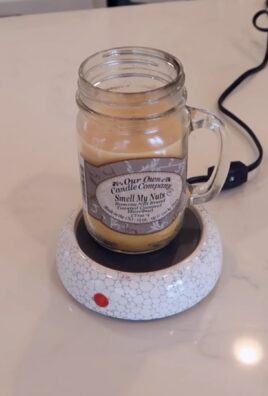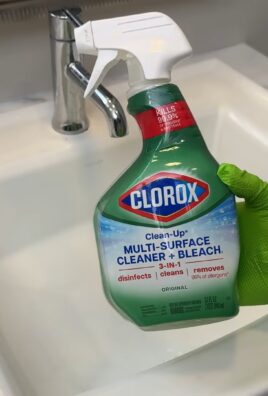Vaseline and vinegar skin treatment – sounds a little unconventional, right? I know, I know, it might not be the first combination that springs to mind when you think about skincare. But trust me, this simple DIY remedy has been whispered about for generations, passed down through families as a secret weapon for achieving soft, smooth, and healthy-looking skin. Think of it as a time-honored beauty hack, like your grandma’s favorite recipe, but for your face!
While the exact origins are a bit hazy, the use of vinegar for skin dates back to ancient civilizations. Egyptians used it for cleansing, while Romans valued its antiseptic properties. Vaseline, a more modern invention, has been a staple in households for over a century, prized for its moisturizing and protective qualities. Combining these two seemingly disparate ingredients creates a powerful, yet surprisingly gentle, treatment.
So, why should you even consider trying a Vaseline and vinegar skin treatment? Well, in today’s world, we’re constantly bombarded with harsh chemicals and expensive skincare products that often promise more than they deliver. This DIY alternative offers a natural, budget-friendly way to address common skin concerns like dryness, uneven texture, and even minor blemishes. Plus, it’s incredibly easy to make at home! I’m excited to share this simple yet effective trick with you, so you can experience the benefits for yourself and unlock your skin’s natural radiance.

DIY Vaseline and Vinegar Skin Savior: A Simple Guide
Hey there, skincare enthusiasts! I’m excited to share a little secret weapon I’ve discovered for achieving smoother, brighter, and healthier-looking skin: a simple DIY treatment using Vaseline and vinegar. Yes, you read that right! While it might sound a little unconventional, the combination of these two readily available ingredients can work wonders. I’ve personally seen amazing results, and I’m confident you will too.
This treatment is fantastic for tackling dry patches, uneven skin tone, and even minor blemishes. But before we dive in, let’s talk about why this seemingly odd pairing actually works.
Why Vaseline and Vinegar?
* Vaseline (Petroleum Jelly): This is a powerhouse emollient. It creates a protective barrier on your skin, locking in moisture and preventing water loss. Think of it as a cozy blanket for your skin. It’s especially helpful for dry, cracked skin.
* Vinegar (Specifically Apple Cider Vinegar): Apple cider vinegar (ACV) is the star of the show here. It contains acetic acid, which is a mild alpha-hydroxy acid (AHA). AHAs are known for their exfoliating properties, helping to slough off dead skin cells and reveal brighter, smoother skin underneath. ACV also has antibacterial and anti-inflammatory properties, which can help with acne and other skin irritations. Important: Always use diluted ACV, as undiluted vinegar can be too harsh and cause irritation.
Important Considerations Before You Start:
* Patch Test is a Must: Before applying this treatment to your entire face or body, perform a patch test on a small, inconspicuous area of skin (like your inner arm) to check for any adverse reactions. Wait 24-48 hours to see if any redness, itching, or irritation occurs. If it does, discontinue use.
* Dilution is Key: Always dilute the apple cider vinegar with water. I recommend starting with a 1:2 ratio (1 part ACV to 2 parts water) and adjusting as needed based on your skin’s sensitivity.
* Sun Sensitivity: AHAs can make your skin more sensitive to the sun. Always wear sunscreen with an SPF of 30 or higher during the day, especially after using this treatment.
* Not for Everyone: This treatment may not be suitable for people with very sensitive skin, eczema, rosacea, or other skin conditions. If you have any concerns, consult with a dermatologist before trying it.
* Listen to Your Skin: Pay attention to how your skin feels. If you experience any discomfort, redness, or irritation, stop using the treatment immediately.
Preparing Your Skin
Before we get to the main event, it’s crucial to prep your skin properly. This will ensure that the Vaseline and vinegar treatment can penetrate effectively and deliver the best results.
1. Cleanse Your Skin: Start by washing your face or the area you’ll be treating with a gentle cleanser. This will remove any dirt, oil, and makeup, creating a clean canvas for the treatment. I personally love using a mild, fragrance-free cleanser to avoid any potential irritation.
2. Pat Dry: Gently pat your skin dry with a soft towel. Avoid rubbing, as this can irritate the skin. You want your skin to be slightly damp, but not soaking wet.
Creating the Vaseline and Vinegar Mixture
Now for the fun part – mixing our ingredients! This is a simple process, but accuracy is important to ensure the right balance of exfoliation and moisturization.
1. Gather Your Supplies: You’ll need:
* Vaseline (petroleum jelly)
* Apple cider vinegar (with the “mother” is best, but any ACV will work)
* Distilled water
* A small, clean bowl or container
* A spoon or spatula for mixing
2. Dilute the Apple Cider Vinegar: In your small bowl, mix 1 tablespoon of apple cider vinegar with 2 tablespoons of distilled water. This creates a 1:2 dilution, which is a good starting point. If your skin is less sensitive, you can try a 1:1 ratio in the future, but always start with the weaker dilution.
3. Add Vaseline: Add 1 tablespoon of Vaseline to the diluted vinegar mixture.
4. Mix Thoroughly: Use your spoon or spatula to mix the ingredients until they are well combined. The mixture might not be perfectly smooth, but it should be relatively uniform.
Applying the Treatment
Now that we have our mixture ready, it’s time to apply it to your skin. This is where the magic happens!
1. Apply a Thin Layer: Using your fingertips, apply a thin, even layer of the Vaseline and vinegar mixture to the desired area. Avoid the delicate skin around your eyes.
2. Massage Gently: Gently massage the mixture into your skin in circular motions for about 1-2 minutes. This will help to exfoliate the skin and promote circulation. Be gentle and avoid scrubbing too hard.
3. Leave it On: Leave the mixture on your skin for 15-20 minutes. This allows the acetic acid in the vinegar to work its exfoliating magic and the Vaseline to lock in moisture.
4. Rinse Thoroughly: After 15-20 minutes, rinse your skin thoroughly with lukewarm water. Make sure to remove all traces of the mixture.
5. Pat Dry: Gently pat your skin dry with a soft towel.
6. Moisturize: Follow up with your regular moisturizer. This will help to replenish any moisture that may have been lost during the treatment.
Frequency and Maintenance
Consistency is key when it comes to skincare. To see the best results from this Vaseline and vinegar treatment, it’s important to use it regularly.
1. Frequency: I recommend using this treatment 1-2 times per week. Overdoing it can lead to irritation and dryness.
2. Adjust as Needed: Pay attention to how your skin responds to the treatment. If you experience any dryness or irritation, reduce the frequency of use. If your skin tolerates it well, you can gradually increase the frequency to 2 times per week.
3. Sunscreen is Essential: As I mentioned earlier, AHAs can make your skin more sensitive to the sun. Always wear sunscreen with an SPF of 30 or higher during the day, even on cloudy days.
4. Hydration: Drink plenty of water to keep your skin hydrated from the inside out.
5. Healthy Diet: A healthy diet rich in fruits, vegetables, and antioxidants can also contribute to healthy, glowing skin.
Troubleshooting and Tips
Even with the best instructions, things can sometimes go awry. Here are some common issues you might encounter and how to address them:
* Redness or Irritation: If you experience redness, itching, or irritation, stop using the treatment immediately. Apply a soothing moisturizer and avoid using any other harsh products on your skin until the irritation subsides. In the future, use a weaker dilution of apple cider vinegar or reduce the frequency of use.
* Dryness: If your skin feels dry after the treatment, make sure you’re using a good moisturizer. You can also try applying a thin layer of Vaseline to your skin after moisturizing to lock in extra moisture.
* No Results: If you don’t see any results after a few weeks of using the treatment, you may need to adjust the dilution of the apple cider vinegar or the frequency of use. However, be careful not to overdo it, as this can lead to irritation. It’s also important to remember that everyone’s skin is different, and what works for one person may not work for another.
* Smell: Some people find the smell of apple cider vinegar unpleasant. If this is the case for you, you can add a few drops of your favorite essential oil to the mixture to mask the smell. Lavender, chamomile, and tea tree oil are all good options for skincare. However, be sure to use essential oils that are safe for topical use and dilute them properly.
* Storage: I recommend making a fresh batch of the Vaseline and vinegar mixture each time you use it. This will ensure that the ingredients are fresh and effective.
Alternative Uses
While I primarily use this treatment on my face, it can also be used on other parts of the body to address various skin concerns.
* Dry Elbows and Knees: This treatment is great for exfoliating and moisturizing dry, rough elbows and knees.
* Cracked Heels: Apply the mixture to your cracked heels before bed, cover with socks, and wake up to softer, smoother feet.
* Dark Spots: Some people have found that this treatment can help to lighten dark spots and hyperpigmentation over time. However, it’s important to be patient, as it may take several weeks or months to see noticeable results.
* Acne Scars: The exfoliating properties of apple cider vinegar can help to fade acne scars over

Conclusion
So, there you have it! This simple yet surprisingly effective Vaseline and vinegar skin treatment is more than just a quirky DIY; it’s a potential game-changer for achieving smoother, brighter, and healthier-looking skin. We’ve explored how the occlusive properties of Vaseline, combined with the gentle exfoliating action of vinegar, can work synergistically to address a range of skin concerns, from dryness and dullness to minor blemishes and uneven texture.
Why is this a must-try? Because it’s accessible, affordable, and customizable. You likely already have these ingredients in your home, saving you a trip to the store and a hefty bill for expensive skincare products. The simplicity of the process means you can easily incorporate it into your existing routine without disrupting your schedule. And, most importantly, the potential benefits – improved hydration, gentle exfoliation, and a noticeable radiance boost – are well worth the minimal effort.
But don’t just take our word for it. We encourage you to experiment with this Vaseline and vinegar skin treatment and discover its potential for yourself. Remember to start with a small patch test to ensure your skin tolerates the mixture well, and adjust the vinegar concentration to suit your skin’s sensitivity.
Variations and Suggestions:
* For Dry Skin: Consider adding a drop or two of your favorite facial oil (argan, rosehip, or jojoba oil work well) to the Vaseline and vinegar mixture for an extra boost of hydration.
* For Sensitive Skin: Opt for apple cider vinegar, which is generally milder than white vinegar. You can also dilute the vinegar further with water or rosewater.
* For Targeted Treatment: Apply the mixture specifically to areas with dryness, rough patches, or minor blemishes. Avoid applying it to open wounds or irritated skin.
* Overnight Mask: For a more intensive treatment, apply a thin layer of the Vaseline and vinegar mixture before bed and leave it on overnight. Be sure to protect your pillowcase with a towel.
* Pre-Shower Treatment: Apply the mixture 15-20 minutes before showering to allow the ingredients to work their magic. The warm shower will help to further soften and exfoliate the skin.
The beauty of this DIY trick lies in its adaptability. Feel free to tweak the recipe and application method to find what works best for your unique skin type and concerns. The key is to be patient, consistent, and mindful of your skin’s reaction.
We are confident that with a little experimentation, you can unlock the transformative potential of this simple yet powerful combination. So, go ahead, give it a try! And most importantly, we want to hear about your experience. Share your results, tips, and variations in the comments below. Let’s create a community of skincare enthusiasts who are passionate about achieving healthy, radiant skin through natural and accessible methods. Your feedback will not only help others but also contribute to a deeper understanding of the benefits of this incredible Vaseline and vinegar skin treatment. We can’t wait to hear your success stories!
FAQ
What exactly does Vaseline do for the skin?
Vaseline, or petroleum jelly, is a powerful occlusive moisturizer. This means it creates a physical barrier on the skin’s surface, preventing moisture from escaping. It doesn’t add moisture to the skin, but it locks in existing moisture and protects the skin from environmental aggressors like wind and cold. This makes it incredibly effective for treating dry, cracked, or irritated skin. It also helps to heal minor cuts and burns by creating a protective layer that promotes healing.
Why is vinegar used in this skin treatment?
Vinegar, particularly apple cider vinegar (ACV), contains acetic acid, a mild alpha-hydroxy acid (AHA). AHAs are known for their exfoliating properties. They help to loosen the bonds between dead skin cells, allowing them to be shed more easily. This can result in smoother, brighter, and more even-toned skin. Vinegar can also help to balance the skin’s pH level, which can be beneficial for those with acne-prone or oily skin. However, it’s crucial to dilute vinegar properly before applying it to the skin, as undiluted vinegar can be irritating or even cause burns.
Is this Vaseline and vinegar treatment safe for all skin types?
While many people can benefit from this treatment, it’s not suitable for everyone. Individuals with very sensitive skin, eczema, rosacea, or open wounds should avoid using it. It’s always recommended to perform a patch test on a small, inconspicuous area of skin (like the inside of your wrist) before applying the mixture to your entire face. If you experience any redness, itching, burning, or irritation, discontinue use immediately. If you have any underlying skin conditions, consult with a dermatologist before trying this treatment.
How often should I use this Vaseline and vinegar treatment?
The frequency of use depends on your skin type and tolerance. For most people, using this treatment 1-2 times per week is sufficient. If you have very dry skin, you might be able to use it more frequently, but be sure to monitor your skin for any signs of irritation. If you have sensitive skin, start with once a week and gradually increase the frequency as tolerated. Avoid using this treatment on consecutive days.
What type of vinegar is best for this treatment?
Apple cider vinegar (ACV) is generally recommended for this treatment because it’s milder than white vinegar. However, white vinegar can also be used, but it should be diluted more heavily. Always choose raw, unfiltered ACV with “the mother” for the most beneficial properties. The “mother” contains beneficial bacteria, enzymes, and proteins that can further enhance the skin’s health.
How much vinegar should I use in the mixture?
The amount of vinegar you use will depend on your skin’s sensitivity. A good starting point is a 1:3 ratio of vinegar to Vaseline (e.g., 1 teaspoon of vinegar to 3 teaspoons of Vaseline). If you have sensitive skin, you can start with an even more diluted mixture, such as a 1:5 ratio. Gradually increase the concentration of vinegar as tolerated. Always err on the side of caution and start with a lower concentration to avoid irritation.
Can I leave the Vaseline and vinegar mixture on overnight?
Yes, you can leave the mixture on overnight for a more intensive treatment. However, it’s important to apply a very thin layer to avoid clogging pores. Also, protect your pillowcase with a towel to prevent staining. If you experience any discomfort or irritation, remove the mixture immediately.
Will this treatment help with acne?
While the exfoliating properties of vinegar can help to unclog pores and reduce the appearance of blemishes, this treatment is not a cure for acne. It may help to improve mild acne, but it’s not a substitute for prescription acne medications. If you have moderate to severe acne, consult with a dermatologist for appropriate treatment options.
Can I use this treatment on other parts of my body?
Yes, you can use this treatment on other parts of your body, such as your elbows, knees, and feet, to treat dryness and rough patches. It’s particularly effective for softening calluses and cracked heels.
What should I do after using this Vaseline and vinegar treatment?
After using this treatment, rinse your skin thoroughly with lukewarm water and pat it dry with a soft towel. Follow up with a gentle moisturizer to lock in hydration. Avoid using harsh cleansers or exfoliants immediately after this treatment. It’s also important to wear sunscreen during the day, as the exfoliating properties of vinegar can make your skin more sensitive to the sun.





Leave a Comment